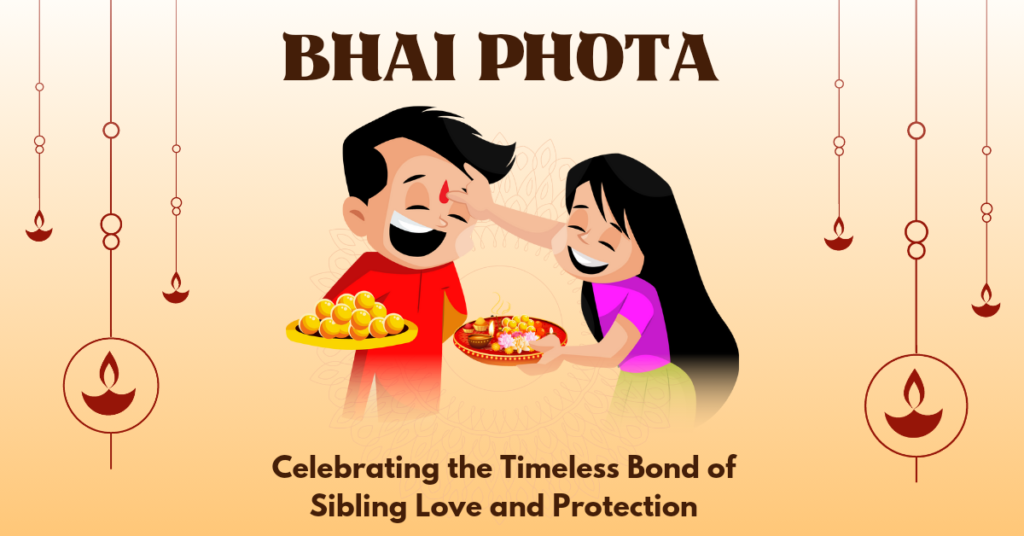Bhai Phota—known as Bhai Dooj in Hindi and Bhai Phota in Bengali—is a cherished Hindu festival that celebrates the deep, unbreakable bond between brothers and sisters. Held on the second day after Diwali, it’s a day of heartfelt rituals and blessings, emphasizing love, protection, and unity within families. Though similar in spirit to Raksha Bandhan, Bhaifota has its own unique traditions and myths, lending it a special charm that siblings across India look forward to each year.
Origins and Legends of Bhai Phota
Bhai Phota’s roots reach deep into Hindu mythology, where ancient tales highlight the sacred connection between siblings. Here are some of the beloved stories that enrich the meaning behind this festival:
1. Yama and Yamuna: The most popular legend of Bhai Phota is that of Yama, the god of death, and his devoted sister, Yamuna. Longing to see her brother, Yamuna invited him with love and prepared a welcoming ceremony to honor him. When Yama finally arrived, she greeted him with a protective tilak (a sacred mark) on his forehead, offered him sweets, and prayed for his well-being. Deeply touched, Yama blessed her, saying that any brother who receives such a ceremony on this day would enjoy a long, prosperous life. This tender moment forms the heart of Bhaifota, as sisters today apply tilak to their brothers with the same love and care.
2. Krishna and Subhadra: Another beloved tale is of Lord Krishna and his sister, Subhadra. After Krishna’s victory over the demon Narakasura, Subhadra greeted him joyfully, marking his forehead with tilak and offering him sweets in gratitude. This gesture of love and pride in her brother’s bravery is celebrated to this day, as sisters bless their brothers for safety and success.
Also Read: Celebrate This Bhai Phonta with Blended Bengali Foods
Bhai Phota Rituals: A Celebration of Love and Protection
Every element of Bhai Phota’s rituals carries a symbolic meaning, expressing the timeless bond and mutual care between siblings.
- Tilak Ceremony: The ritual begins with the sister carefully preparing a tilak made from sandalwood paste, vermilion, and rice grains, which she then applies to her brother’s forehead. This tilak is a blessing of protection, a wish for a long and prosperous life, and a loving reminder that his sister stands by him.
- Aarti and Prayers: Following the tilak, the sister performs an aarti, a traditional prayer ritual with a lighted lamp. She circles the lamp before her brother, symbolically warding off negative energy and invoking blessings for his well-being. This moment of prayer and blessing holds a quiet yet powerful beauty, as sisters ask for their brothers’ safety in a world filled with uncertainties.
- Gift Exchange: To reciprocate this love and care, brothers often give meaningful gifts to their sisters, a token of gratitude that reflects the special place they hold in each other’s lives.
- Festive Feasting: No Indian festival is complete without food, and Bhaifota is no exception. Families come together for a joyful meal, indulging in sweets and traditional dishes that bring warmth and happiness to the gathering. It’s a time for laughter, memories, and family connections that endure across generations.
Also Read: This Bhai Dooj Treat Your Brother With Different Delicacy
Cultural Significance of Bhai Phota
Bhaifota occupies a cherished place in Indian culture, highlighting the importance of family values, love, and loyalty. Although observed differently across regions—known as Bhaubeej in Maharashtra and Bhai Phonta in West Bengal—the essence remains the same: a celebration of the special, irreplaceable bond between siblings. In every region, this festival strengthens ties, fostering a spirit of mutual care that lasts beyond the rituals of the day.
Celebrated after the vibrant festivities of Diwali, Bhaifota adds a warm, intimate touch to the season, reminding families of the power of sibling love. It is more than a ceremony; it’s a beautiful testament to resilience, mutual support, and the lifelong friendship that siblings share—a bond that shines through life’s highs and lows, guiding and protecting them every step of the way.



